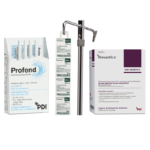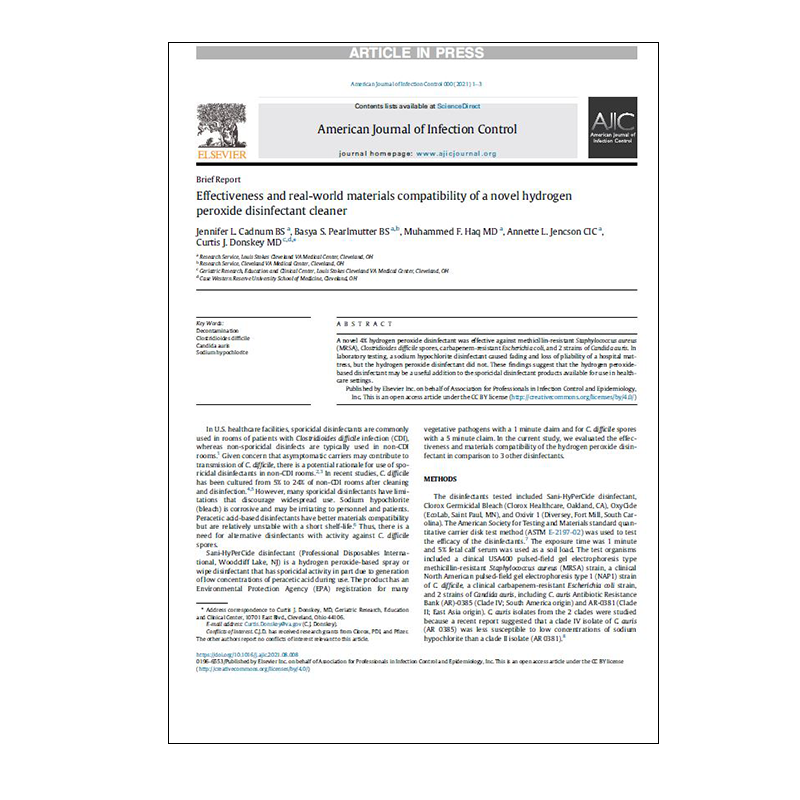Interventional Care


We notice that you are visiting us from . This site only services US-based visitors. Would you like to visit the site that is appropriate for your location?
American Journal of Infection Control recently published an article entitled, “Effectiveness and real-world materials compatibility of a novel hydrogen peroxide disinfectant cleaner” which discusses a novel 4% hydrogen peroxide disinfectant that was effective against methicillin-resistant Staphylococcus aureus (MRSA), Clostridioides difficile spores, carbapenem-resistant Escherichia coli, and 2 strains of Candida auris. In laboratory testing, a sodium hypochlorite disinfectant caused fading and loss of pliability of a hospital mattress, but the hydrogen peroxide disinfectant did not. These findings suggest that the hydrogen peroxide-based disinfectant may be a useful addition to the sporicidal disinfectant products available for use in healthcare settings.
Excerpt from the article:
In U.S. healthcare facilities, sporicidal disinfectants are commonly used in rooms of patients with Clostridioides difficile infection (CDI), whereas non-sporicidal disinfects are typically used in non-CDI rooms.1 Given concern that asymptomatic carriers may contribute to transmission of C. difficile, there is a potential rationale for use of sporicidal disinfectants in non-CDI rooms.2,3 In recent studies, C. difficile has been cultured from 5% to 24% of non-CDI rooms after cleaning and disinfection.4,5 However, many sporicidal disinfectants have limitations that discourage widespread use. Sodium hypochlorite (bleach) is corrosive and may be irritating to personnel and patients. Peracetic acid-based disinfectants have better materials compatibility but are relatively unstable with a short shelf-life.6 Thus, there is a need for alternative disinfectants with activity against C. difficile spores.
Sani-HyPerCide disinfectant (Professional Disposables International, Woodcliff Lake, NJ) is a hydrogen peroxide-based spray or wipe disinfectant that has sporicidal activity in part due to the generation of low concentrations of peracetic acid during use. The product has an Environmental Protection Agency (EPA) registration for many vegetative pathogens with a 1-minute claim and for C. difficile spores with a 5-minute claim. In the current study, we evaluated the effectiveness and materials compatibility of the hydrogen peroxide disinfectant in comparison to 3 other disinfectants.
Highlights

In this PDI Call on Clinical episode, Holly Montejano, MS, CIC, CPHQ, VA-BC, sits down with Kimberly Atrubin, MPH,…
Do not let your guard down! As we enter respiratory virus season, it will be important to prepare for influenza…
Providing accessible, compliant and effective disinfection for dental…
Measles is an acute viral respiratory illness. Airborne isolation protocols should be followed in healthcare including the appropriate use…
The recently released, May 2021, AORN guideline for preoperative skin antisepsis describes the importance of nasal and skin decolonization for the reduction of surgical site infections. This document…
PDI’s Sani-Cloth® Bleach Wipes can help clean more efficiently, keep surfaces looking new for longer, and help protect your…
“Bird Flu” is caused by avian influenza A viruses that typically spread between birds, not humans. Wild water birds…
Protect Patients, Staff, and Visitors in Healthcare Settings: Norovirus is the leading cause of foodborne outbreaks. Over half of…
At PDI, we’re advancing our product range with a commitment to environmental and social responsibility, prioritizing safety, quality, and…
Your Total Environment of Care Solution: From the innovators of germicidal wipes for healthcare, our Environment of Care product…
Compatibility with plastics, metals, and other common materials is a critical design criteria for PDI formulations. We continually test…
Did you know that your phone can house 17,000 germs, and hands can have 4.6 million bacteria? Learn more…